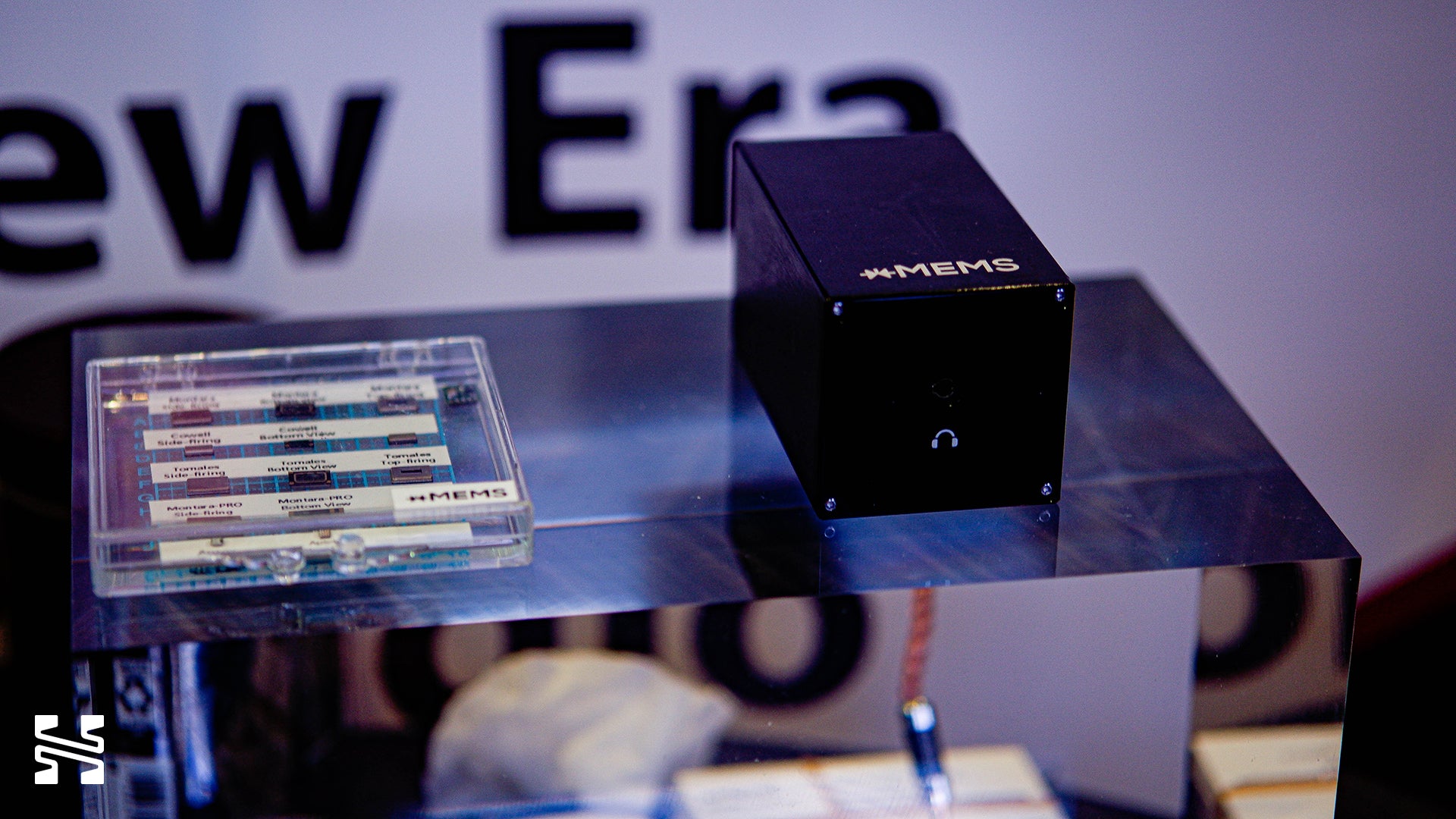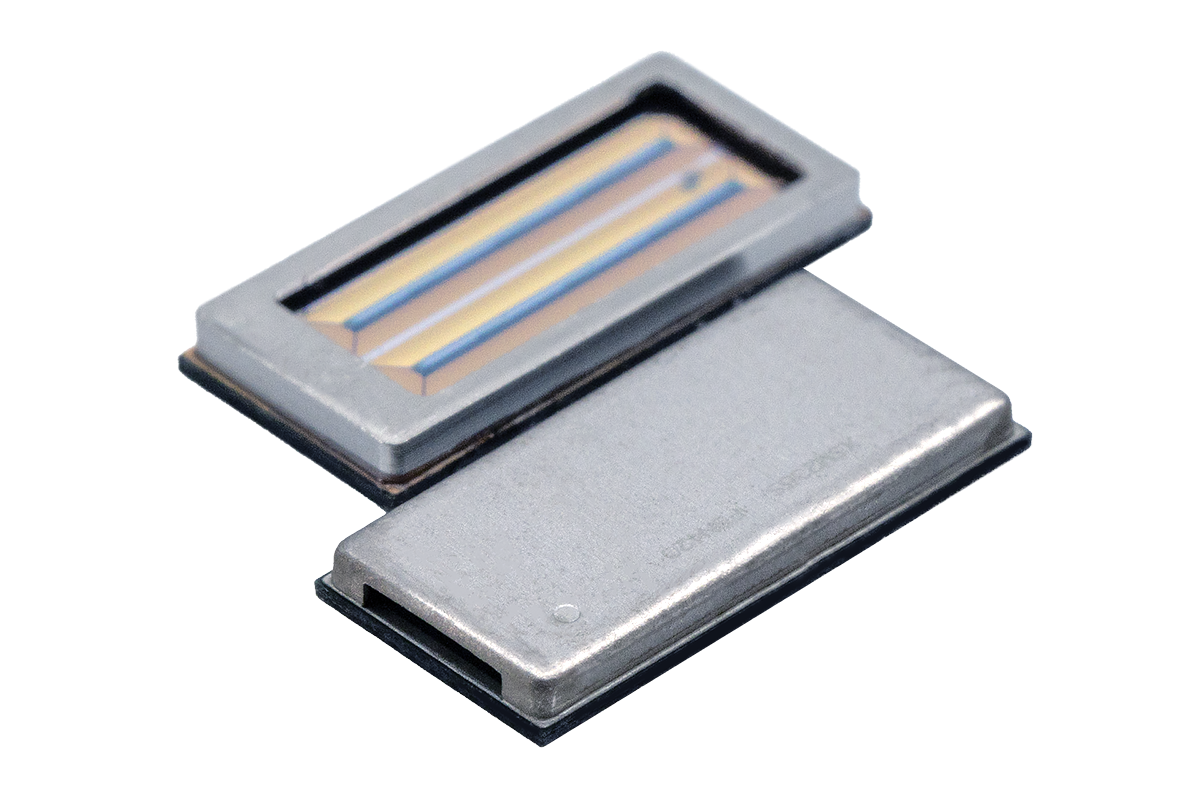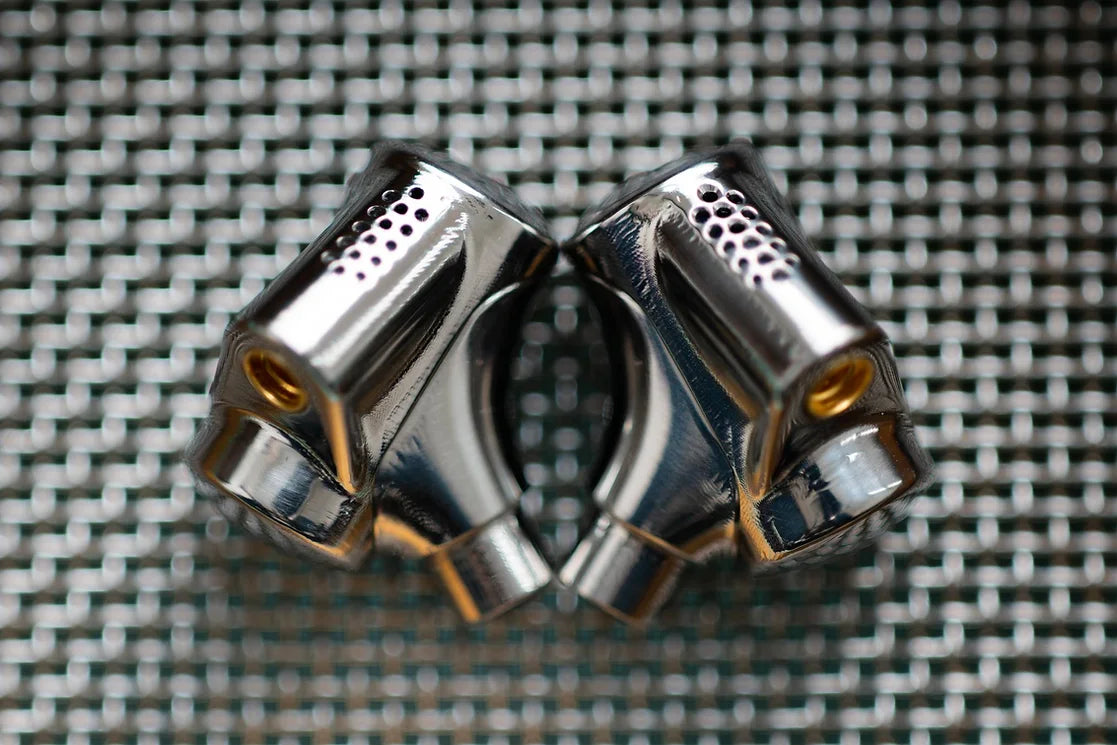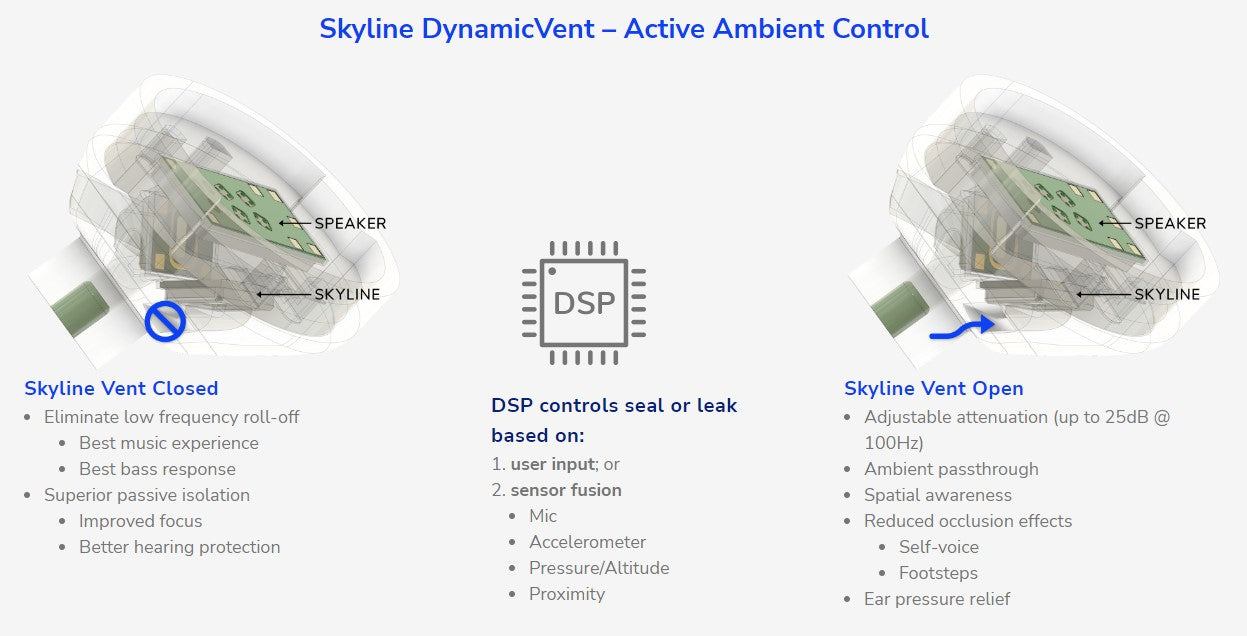CanJam NYC 2023: A Look at MEMS - The Next Step for In-Ear Monitors?

Introduction
One of the great things about being at CanJam is the chance to learn about new innovations. This was best exemplified at the xMEMS showcase. There, I spoke with Michael Ricci, Senior Director of Electroacoustic Engineering at xMEMS, who walked me through a generous demo of their technology and up-and-coming products. But first, a brief primer on xMEMS.
xMEMS is a start-up based in California (where else?) whose raison d’etre is its microelectromechanical system (MEMS) drivers. More specifically, xMEMS utilizes piezoelectric MEMS to create silicon-based microspeakers for in-ear monitors (IEMs). This technology works by sending an electrical signal to vibrate a flexible silicon membrane to produce sound. Crucially, it differs from traditional drivers in not requiring any magnets to drive a voice coil; sound is produced directly from the bending of the silicon membrane as it receives a voltage.

The xMEMS Montara Plus full range driver. I believe this was used in the xMEMS demo unit I listened to. Note how it looks more like a CPU chip than a driver. The exposed yellow/beige silicon membrane oscillates upon an electrical signal to create sound. No magnetic fields required. Image credit to xMEMS.com.
The direct drive of a piezoMEMS offers a whole host of advantages over conventional drivers, including consistency, durability, and responsiveness. But there is one major downside: it requires a constant (bias) voltage to engage its driver, analogous to what electrostatic (estat) headphones utilize. Practically, this means that MEMS drivers cannot be used with standard source gear and will require special electronics to drive them. But interestingly, these MEMS can be powered by the battery of a true wireless (TWS) IEM and that is one of the markets that xMEMS hopes to transform with their technology.
Of course, if you’re reading this you’re almost certainly an audio enthusiast. Driver technology, no matter how exotic, must first sound good. So let’s dive into the demo and explore the world of MEMS.

On the left is a showcase of the various MEMS drivers developed by xMEMS. On the right is an adapter box to convert the output of a standard amplifier for use with a MEMS driver.
xMEMS Demo Unit
The first IEM I tried was the xMEMS demo unit, powered by the iFi iDSD Diablo-X. This demo model features a single xMEMS driver in a 3D printed shell with no tuning applied to as purely demonstrate the capabilities of its driver. As you can see in the image, the nozzle is very short and there is a large circular portion directly behind it. It’s almost like an earbud in its shape. Michael requested I use Comply foam eartips and we went the whole nine yards to ensure I got as good of a seal as possible. We’re talking deep fit and tip twisting for complete occlusion. Unfortunately, while it sealed, the shallow nozzle and circular frame prevented me from getting a comfortable deep insert.
The showcase itself was fairly guided. Michael had a nice selection of test tracks he walked me through - all of them were very well mixed and mastered. From slow acoustic sets with solo vocalists to tightly produced instrumentals from Polyphia and Toe, Michael Jackson’s Beat It was the closest thing to a busy rock track. We played each song for about 30 seconds or so to highlight the different characteristics of the IEM I was listening to. Unfortunately, not having my own music meant I couldn’t look for familiar flaws.

The xMEMS demo unit. Note the short nozzles and circular head.
Given that minimal tuning was done with the demo unit, its tuning was fair. I found it plenty bassy and rich in the lower mids. None of the instruments immediately stood out to me as being tonally off. That is, until I got to the vocal tracks. Though I was unfamiliar with the vocalists, they sounded suspiciously warm, especially for female singers, questioning whether that was their natural voice. It was in Beat It that my suspicions were confirmed - Michael Jackson’s voice lacked upper mids brilliance. The treble was well extended but not overly exaggerated or artificially airy.

The iFi iDSD Diablo-X used to power the xMEMS demo unit. These amps were specifically by iFi made in collaboration with xMEMS for their foray into the IEM world.
It’s on a technical level that this IEM becomes intriguing. The first thing I noted was its staging. The soundstage was constrained. Not so much claustrophobic but rather focused within the head. This was accompanied with some very nice imaging. The center image of vocalists had great depth, as if they’re coming from deep within your mind rather than just behind your eyes. It reminds me of the first time I heard the Etymotic ER4 which has a similar presentation in its vocal imaging. Instruments similarly had excellent precision with each note dancing spatially around where the main body of the instrument is placed. Needless to say, separation was very good. At the risk of sounding cliché, it sounded live. Like you were on stage rather than listening through the mics of a recording, particularly for vocals.
The bass of the xMEMS demo unit was unique. Michael played a couple bass- heavy songs to show off what it could do. And it delivered. The bass presents a feeling of excursion that’s different from a dynamic driver. There's a perception that air is pushed freely by the MEMS driver to create sheer volume at the lowest octaves. There is a lot of control and precision on display, like the driver is carving out the sound waves, but it lacks some of the sense of weight and dynamics behind each note commonly found in dynamic drivers.
The last point of interest is its treble response. It’s highly articulate. As a whole, it gives the xMEMS demo unit a very snappy feeling and ties its sound together. Every note is clean and tight. Yet, I didn’t find it to be a sharp IEM. I didn’t detect any sibilance or harshness in the treble. There weren’t any major peaks piercing my ears. Though lively, it wasn’t fatiguing in the least. I suspect MEMS drivers will find a lot of success in implementations as a tweeter to handle treble notes in hybrid configurations.
Singularity Audio ONI
Next Michael showed me the Singularity Audio ONI. It’s an IEM that sports two MEMS drivers. The unit I tried was particularly interesting as it was attached to an MMCX cable with an in-line volume control module below the Y-split. This module contained a couple chips and terminated in USB-C instead of 3.5 mm. In other words, no iFi Diablo-X was needed. Michael ran it straight from his iPhone during the demo. Furthermore, this control module applied a basic level of DSP to the ONI which meant that I was effectively listening to an EQ’d unit. Unfortunately, I had some fit issues as well. The design of the shell is unusual and it wasn’t obvious how it was meant to be angled in ear. It additionally suffers from the same short nozzle as the demo unit.

The Singularity Audio ONI. I was requested not to take a photo of the unit I had listened to. Note once again the short nozzles. Perhaps it was necessary to achieve the tuning they wanted? Image credit to singularityaud.io.
Soundwise, the ONI had many similar traits to the xMEMS demo unit. The key difference was twofold. First, the in-line DSP (EQ) gave it a much more balanced tuning. It wasn’t quite as midbass-heavy and had a clearer subbass tint. The upper-mids was much better filled in and vocal timbre was restored. Secondly, its soundstage was larger and more diffused but imaging was a little less precise. The same snappiness and articulation of the xMEMS demo unit was present ONI leading to a similar overall feel. It seems that perhaps MEMs IEMs may have a “timbre” of their own. I also briefly snuck in a listen using my own silicon tips (AZLA Sednas) and it still sounded pretty good, though perhaps there was a bit of a roll-off at the lowest octaves.
Thoughts and Caveats
What I saw at the xMEMS booth was potential. With IEMs, I tend to find that bass and upper treble performance factor heavily in differentiating products. The xMEMS demo unit and ONI showed that they had something unique to offer in the way it presented sound. In a market so saturated with similar sounding products, every edge counts when it comes to captivating your audience.
However, I see a couple of caveats with this demo. Let’s start with the most obvious one. The fact that you need specialized equipment to power a MEMS driver may be a barrier to entry. It’s reminiscent of the estat conundrum - energizers aren’t cheap. But to be fair, they did have a USB-C-to-MMCX cable that worked fine and they have working TWS implementations of MEMS drivers so… estat analogues for everyone?
The second big caveat with the showcase was how much of a “best case scenario” it was. This was an engineer’s demo - perfectly recorded music under controlled conditions with little freedom for the listener. I’ll just say it upfront: it’s not realistic to expect customers to achieve a perfect seal every time they want to listen to music. That is antithetical to widespread appeal, particularly if xMEMS is aiming for the TWS crowd. My concern is that these MEMS drivers may be very susceptible to imperfect seals for its bass response. This was corroborated when a friend of mine reported a severe lack of bass in his listening session - the opposite of my experience. That said, I’m certain xMEMS is aware of this as they have a DD + MEMS combo unit in the works.
As with everything I heard at CanJam, do take these impressions with a few grains of salt. I hope to be able to get my hands on a few units in the future and give these xMEMS products a proper review in an everyday setting.
Conclusion
Like every start-up, xMEMS’ marketing loves to throw words around like “disruptive” when talking about their technology. From a wider perspective, the novel applications of MEMS technology as a whole to confer significant advantages across multiple industries was a recurring message in my research. It has undoubtedly, though perhaps quietly, transformed familiar sectors. Specifically for IEMs, the fundamentally different operating principle of MEMS drivers may admit its swift rise in consumer products. The rapidly-growing TWS market and the increasingly sophisticated employment of DSP to both enable “smart” audio and address MEMS driver limitations may just be enough to disrupt the broader consumer market as xMEMS hopes.

An example from xMEMS of a TWS IEM with DSP controls to modulate the user experience. Note the multitude of quality-of-life features and expected audio improvements as a result of “smart” sensors or user-based decisions. Image credit to xMEMS.com.
But for the “audiophiles” reading this article, I see MEMS drivers more as another tool to shape unique auditory experiences in the hands of a skilled designer rather than the final form of future Hi-Fi IEMs. Though it uses an exotic driver with distinct properties, being different for the sake of being different hasn’t always been a winning formula. Not to mention that manufacturers are still finding ways to coax new levels of performance from familiar parts as evidenced by some of the great IEMs I heard at CanJam. As far as marketing strategy goes, where to play and how to win are the first two questions that must be asked. How xMEMS chooses to answer will determine their overall presence and ultimate success in our little corner of the audio universe.
